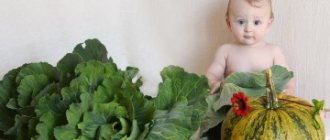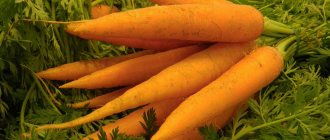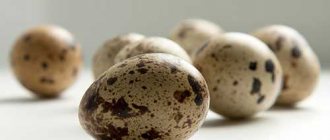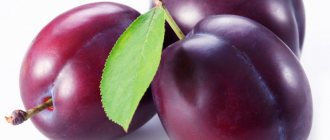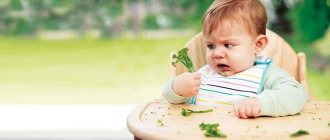Benefits for the child
Plum contains the following beneficial substances:
- B vitamins contribute to the full development of the baby’s nervous system and prevent excessive anxiety.
- Vitamin C has an anti-inflammatory effect, helps the child’s body fight viruses and significantly strengthens the immune system.
- Provitamin A has a beneficial effect on children's vision and stops its deterioration.
- Vitamins of group P (or bioflavonoids) strengthen the baby’s blood vessels and prevent surges in blood pressure when the weather changes (i.e., they help fight weather dependence).
- Sodium prevents the appearance of edema, which, fortunately, is rare in children.
- Calcium is an essential element for a growing body. Its sufficient content in plum fruits improves the condition of the child’s bones and dental health.
- Potassium has a positive effect on the functioning of the cardiovascular system;
- Copper is required for the growth and proper development of the baby.
Plum contains a large number of other minerals: nickel, silicon, fluorine, manganese, zinc, iodine, phosphorus and others.
This stone fruit culture will be useful for children with intestinal disorders. The fruits have a mild laxative effect, helping the child cope with constipation. The laxative effect of plum stems from the content of a special substance in its composition - isatin and a high level of fiber.
What are the benefits of plums?
We can talk for a long time about the healing properties of plums, but let’s focus on the most interesting ones. The use of the fruit as a medicinal product is due to its rich content of vitamins and minerals, as well as fiber and pectins.
- An excellent remedy for constipation, which has a mild laxative effect.
- Due to their high potassium content, plums help remove excess fluid from the body - the diuretic effect is weak, so the body does not experience stress.
- An effective intestinal stimulant - both fresh and dried fruits have this effect.
- The fruit is good for the heart.
- It has a choleretic effect, due to which food is better digested.
- Improves appetite.
- Serves as a stimulator for the formation of new red blood cells.
- In dried form, plums can be used as an antipyretic.
- Strengthens the liver.
- Normalize the acid-base balance.
- Plums are useful for certain disorders of the gastrointestinal tract.
- This fruit will help get rid of heartburn.
- Plum contains a significant amount of vitamin E, known for its powerful antioxidant effect; the condition of hair, skin and nails depends on its intake in the body.
- Plum is recommended for rheumatism and gout.
- Plum juice is valued for its antibacterial properties.
- Reduced absorption of cholesterol.
Video recipe for the occasion:
:
Nutritional table
You can find out quantitative characteristics of the main nutrients contained in plums from the table.
| Vitamins | Minerals | ||
| A | 569 IU | Potassium | 259 mg |
| C | 15.7 mg | Phosphorus | 26 mg |
| B1 (thiamine) | 0.04 mg | Magnesium | 12 mg |
| B2 (riboflavin) | 0.04 mg | Calcium | 10 mg |
| Niacin | 0.6 mg | Sodium | 0 mg |
| Folate | 8 mcg | Iron | 0.28 mg |
| Also contains trace amounts of other vitamins, manganese, copper and zinc | |||
Composition and calorie content
Plums can serve as a source of many substances useful for the growth and development of children, while the fruit has a low calorie content: 100 g contains only 49 kcal.
100 g of fruit contains:
- 9.6 g of carbohydrates (including mono- and disaccharides - 9.5 g, starch - 0.1 g);
- 0.8 g proteins;
- 0.3 g fat;
- 1 g organic acids;
- 1.5 g dietary fiber;
- 0.5 g ash;
- 86.3 g water.
The fruits also contain a wide range of vitamins:
- ;
- RR;
- ;
- ;
- some B vitamins.
The content of macro- and microelements in 100 g of plums is also impressive:
- calcium;
- iron;
- sodium;
- phosphorus;
- magnesium;
- zinc;
- copper;
- iodine;
- potassium;
- manganese;
- sulfur;
- chlorine;
- chromium;
- silicon;
- fluorine;
- cobalt;
- molybdenum;
- nickel.
The leaves of the plant contain the presence of coumarin, a substance that promotes the dilation of blood vessels supplying the heart muscle. Thus, coumarin prevents the formation of blood clots.
When and how much to give?
Photo: Depositphotos.com Author: Lovelymama
Plums are introduced into complementary foods for babies no earlier than 8-9 months. But American pediatricians allow plum puree to be given to a child as early as 6 months. It is important that by the time the baby gets acquainted with this product, he has already tried most other fruits, including stone fruits, and they do not cause allergies.
It is advisable to choose the first plums for complementary feeding that are yellow in color - they are less likely to cause allergies. The most suitable dishes for a baby are mashed potatoes and compote.
At first, plum puree should be added to fruits already familiar to the baby, such as an apple. No need to give more than a spoon. Gradually, in the absence of allergies, the volume of plums in fruit puree is increased, and then they switch to monocomponent plum puree.
Compote made from dried plums (prunes) is better absorbed by the baby’s body. For the first time, it is advisable to give the child no more than 20 ml of the drink. If no signs of allergy appear within three days, the portion can be gradually increased.
When a child has serious intestinal problems that cause frequent constipation, the pediatrician may recommend a prune decoction starting from 4 months. But such early complementary feeding should be carried out exclusively under the supervision of a doctor and with great caution.
What to cook from plums
In addition to plum puree, plum compote, especially dried fruit, is perfect for a small child. Prune compote is easily and quickly digested, cleanses the body and strengthens the immune system, improves digestion.
Dilute the first portions of the drink with water, gradually increasing the concentration of the compote. Start with 20 ml. At 1-1.5 years old, you can give a child half a glass, after two years - a full glass.
Plums go well with apples and blueberries, apricots and peaches, cranberries, melon, cooked chicken and yogurt. You can add fruit to porridge and cottage cheese. Prepare fruit salads, jams and pies for children. Kids will definitely appreciate the variety and taste of the dishes. We offer recipes using plums.
Why is it not suitable for first feeding?
- Plum is a product that often causes allergies in children. Therefore, its introduction into complementary foods is permissible only after other fruits that are less likely to cause an undesirable reaction from the body.
- In addition, plum fruits have a laxative effect. It is difficult to predict to what extent the child’s body will react to this product if nothing other than breast milk or formula has not yet been tried.
- The fruit has a serious effect on the acidic environment of the stomach. Therefore, you should first prepare the baby’s body for a new product with another food that is gentler on the gastric mucosa.
- And last but not least, complementary feeding should start with vegetables. And after eating sweet and tasty fruits, the child often refuses them.
Possible harm and contraindications
All stone fruits are allergenic foods, and plums are no exception. When consuming this fruit, signs of allergies often occur - eating disorders, diarrhea, skin rashes. That is why it is introduced into complementary foods only after “getting acquainted” with the rest of the stone fruits.
Main contraindications for use:
- diabetes;
- stomach or duodenal ulcer;
- pancreatitis;
- increased level of stomach acidity.
Plums in children's diets should be present in minimal portions. They have a laxative effect and too much of these fruits can lead to serious stool upset. Overeating plums contributes to the development of intestinal dysbiosis, bloating and stomach cramps.
Pediatricians recommend that parents always start infant feeding with vegetable purees. This is due to the fact that fruits have a pleasant and delicate taste, so many kids, having tried fruit puree, categorically refuse vegetable dishes.
Tips for choosing
In order for plums to benefit the child’s body, you should carefully select the fruits.
- You need to take only ripe specimens without dents. Be sure to check the fruit for rotten areas. Even with minimal damage, giving fruit to the baby is strictly prohibited.
- There are more than 2,000 varieties of plums in the world, so it is simply impossible to list all those suitable for a child. But the baby will like sweet varieties (skoroplodnaya, blue gift, etc.) more, and their acidity is relatively low.
- Due to the high allergenicity of plums, it is advisable to choose yellow or white fruits. When consuming red and purple specimens, allergic risks increase.
- Buy your child fruits that were grown and collected near your place of residence. “Native” fruits will bring much more benefits than “overseas” ones.
So what's the difference?
A baby who is fed only breast milk rarely suffers from constipation. This is explained by the fact that milk consists of approximately 87% water; in addition, all its components are maximally adapted to children's needs, so they are absorbed easily and quickly.
Any breastfeeding consultant will say that the absence of stool even for up to 5-7 days, if the child does not show signs of discomfort (does not cry, does not strain, the tummy is not tight), is not considered constipation in an infant. Therefore, if you encounter such a “delay”, but the baby behaves as usual, do not rush to take action. Feed the baby on demand, while the mother can eat the plum herself to “relax” the baby’s tummy. And if it’s summer and hot outside, you can gradually give your baby water from a teaspoon to replenish fluid loss.
Another thing is a child on artificial or mixed feeding. Sometimes even an incorrectly selected mixture can cause problems with the gastrointestinal tract. Frequently changing brands of artificial nutrition can also cause constipation. Another risk factor is a lack of fluid, because a child on IV must be supplemented with food (in a day he must drink approximately as much water as he eats formula in one feeding). And of course, no formula is comparable to breast milk in terms of the number of useful substances - milk contains more than 300 of them (and these are only those that have already been discovered and studied), and in artificial nutrition, on average, from 30 to 60 types. Therefore, doctors advise children on IV to introduce complementary foods earlier.
A selection of children's recipes
To preserve the maximum vitamins and mineral elements in plum complementary foods, it is necessary to prepare it correctly. Usually, two dishes are perfect for children under one year old: puree and compote.
Plum puree
- Be sure to thoroughly rinse the fruits, pour boiling water over them and immediately remove the scalded skin with a thin knife.
- After this, cut the plum into 2 halves and remove the pit.
- Place in a blender and blend until smooth.
- If your baby's puree is too thick, you can dilute it with a little water.
Chicken puree
If your baby has already switched to meat feeding and has already become familiar with chicken, you can prepare plum puree with chicken for him.
The recipe is recommended for children over 8 months.
- You need to take 3 peeled plums, remove their seeds and cut them into cubes.
- Cut one chicken fillet in the same way.
- Place everything together in a saucepan, add a glass of water and simmer over low heat until the meat is cooked.
- Then cool slightly and turn the contents of the saucepan into puree using a blender.
Compote
To prepare plum compote you will need 250 g of fruit and 750 g of water. If the compote is intended for a child older than one year, you can add a couple of spoons of sugar.
- Wash the plums and remove the pits.
- Place in cold water, add sugar if necessary.
- Put on fire. After boiling, cook the compote for 2 minutes.
- Cover the saucepan with a lid and leave to steep.
After 2-3 hours you can give the compote to your baby. If your child is just getting acquainted with a new fruit, do not forget to strain the drink before serving.
Recipes for dishes with plums for children
Plum compote
- Plums – 250 grams;
- Water – 750 grams.
We wash the berries, cut them into halves, and remove the seeds. Fill with water, add 1-2 tablespoons of sugar. Bring to a boil and cook for 2 minutes. Leave covered for a couple of hours. A tasty and healthy drink is ready.
Paste
- Plums – 1 kg;
- Sugar – 200 grams.
Pastila will be a suitable and healthier substitute for sweets. This delicacy is perfect for nursing mothers and babies older than one and a half to two years. Wash the berries and add sugar. When they release juice, place the container on the stove and bring to a boil. Boil for an hour, then cool and grind through a sieve or grind in a blender or mixer.
Boil the resulting plum puree for two hours and cool. Line a baking dish with parchment or special paper and spread the plum mixture on top in a thin layer. Dry in the oven in several stages at temperatures up to one hundred degrees until done.
Plum charlotte
- Plums – 1⁄2 kg;
- Chicken eggs – 4 pcs.;
- Flour – 1 glass;
- Sugar – 1 glass.
Charlotte can be made not only from apples. To prepare the pie, the plums need to be washed, peeled, pitted and cut into pieces. Beat sugar and eggs, carefully add sifted flour and knead the dough. Grease a baking container with oil and pour in half of the resulting mixture, lay out the plums and fill with the rest of the dough. Bake for half an hour at 180 degrees. The cake turns out airy, light and very tasty.
Quick jam without cooking
- Plums – 300 grams;
- Sugar – 150 grams.
We wash the plums, dry them, cut them into halves, and remove the pits. Place the berries cut side down in sterilized jars, sprinkling each row with sugar. Close the lid and pasteurize. The result is a plum in its own juice, which will preserve the vitamins and beneficial properties of the fresh product as much as possible. It will make up for the lack of important elements during the cold season and the child will definitely like it. You will find other interesting recipes for children at the link.
Preparation for the winter
If the age at which months you can introduce plums into complementary foods falls in the winter, it is better to take care of preparing puree for the winter in advance.
- Wash the fruits, peel and remove the seeds.
- Hold over steam for 2-3 minutes to soften.
- Grind with a blender and heat without boiling.
- Pour the finished puree into sterilized jars to the brim and close with lids.
- Cool at room temperature, turning the jars upside down.
For winter preparations, the ripest and sweetest fruits are chosen.
How to freeze and dry plums
To freeze plums, choose unripe fruits or firm varieties. Rinse thoroughly, sort and dry the fruit. Then let it ripen at room temperature, then place it in the refrigerator for 15 hours. Finally, pack the plums in cling film, a plastic bag or a closed container and put them in the freezer for long-term storage. Frozen plums can be stored for about a year.
To dry plums, wash, sort and dry the fruits, bringing them to maximum ripening at room temperature. Dip the fruit in a hot 1% soda solution for a minute. Then rinse the plums again and air dry. After this, place the berries on a baking sheet and dry for two to three hours at 45 degrees, leaving the oven door slightly open.
After this treatment, they take a break for five hours, after which the plums are again sent to the oven. The fruits are left for 10-12 hours at a temperature of 80 degrees. Prunes are stored in wooden boxes with holes or in a glass jar with a tight-fitting lid.
Caution won't hurt
Despite the benefits of plum for the baby, before introducing it into complementary foods, it is necessary to take into account the following contraindications:
- If a child has problems with the gastrointestinal tract or reacts poorly to new foods, eating plums will worsen the situation.
- It is not advisable for children under three years of age to give such fruits in their usual form - whole or in halves. This can injure the delicate gastric mucosa. In addition, the baby may swallow the bone or even choke on it.
- If a child has diarrhea, plums should be completely excluded from the diet, including in the form of a compote made from these fruits.
It is necessary to prepare puree and compotes from plums in August-September. During this period, fruits ripen naturally, without the participation of harmful fertilizers, and contain all the necessary vitamins. Fruits purchased at other times of the year, no matter how attractive they may be at first glance, are not recommended to be given to children.
Do not be surprised if your child experiences diarrhea after eating plum puree, since the product contains laxatives. Most of them are concentrated in the fruit skin, which is why its removal significantly reduces the likelihood of diarrhea in the baby. If this does happen, you need to postpone plum complementary feeding for at least half a month and next time start complementary feeding with a smaller portion.
Consequences of use
- Child's stomach hurts after eating plums . This condition usually occurs when too many fruits are eaten. You should not give them to children too much or too often. Enough 1-2 times a week in the amount of 2 pieces.
- Diarrhea from plum . With moderate consumption, a similar disorder can occur from imported fruits, which most likely have been treated with chemicals. Also, do not forget about thorough washing and heat treatment of fruits.
- The child is allergic to plum . If after consumption a negative reaction from the body develops (hives, rash on the face, redness, rhinitis, conjunctivitis), it is necessary to postpone the introduction of the product into the diet for 2-3 months.
Allergy to plum
Plums are contraindicated for children prone to allergic reactions. This fruit often causes allergies, so its introduction into complementary foods should be delayed until three years of age, when the baby’s gastrointestinal tract is fully formed.
Experts associate the body’s negative response to plums with sensitivity to birch pollen. Therefore, if one of the parents suffers from seasonal reactions, there is a high probability of allergies in the baby.
In addition to plums, the following foods are correlated with birch pollen intolerance:
- fruits: apples, pears, peaches, cherries, kiwi;
- vegetables and herbs: carrots, fennel, potatoes, spinach and celery;
- nuts: peanuts and hazelnuts;
- buckwheat;
- flower honey
The allergens in plums are not destroyed by heat treatment, as some people mistakenly believe. Therefore, boiled or scalded fruits do not become safer for particularly sensitive babies.
Plum during pregnancy
It is known that while expecting a baby, many women suffer from digestive problems, and they are often bothered by constipation. In this case, plums will provide invaluable help. Just a few fruits in the morning on an empty stomach and in the evening before bed will improve your intestinal function in just a few days.
The plums known as "Agen" were created by the monks of Clerc's Abbey by crossing two varieties, hence the name "Agen prune". Plum is made up of more than 80% water and reports good calorie intake. There are many varieties of plums: different colors, some are sweeter and others are more acidic. You're sure to find one that suits you and your baby will love it!
Plus, plums have a very high concentration of antioxidants that help prevent bad cholesterol, heart disease, and some types of cancer. Plum is a fruit with laxative properties, which is very valuable for people with digestive and intestinal disorders.
Plum contains many valuable substances necessary. These include vitamin E, folic acid, potassium, iodine and iron. These substances are especially valuable for the expectant mother. They are responsible for the proper development of the fetus, eliminate signs of toxicosis, anemia and the risk of placental abruption.
Plum is an excellent preventative against and helps preserve teeth. Plum fruits perfectly cleanse the body of free radicals and protect against the harmful effects of the environment. But despite all the benefits during pregnancy, you should not eat plums thoughtlessly. Follow these simple guidelines:
Iron, magnesium, copper, manganese and potassium. On the digestive level, plums are well supplied with fibres: these latter make it possible to stimulate good intestinal function in everyone! When purchasing, choose plums that are free of blemishes, soft, smooth and undamaged. Plums may be covered with a light white veil: decent. Safe for health, this substance allows the fetus to protect itself from the sun.
You can save your plums. Outdoors if they are not yet ripe. Refrigerate for 5 days. A child can consume plums from 8 months. You can offer him plum composts combined with other fruits; when it grows up, it will be possible to give everything to discover the textures.
- Do not eat unwashed or unripe fruits.
- Don't eat too many plums. It is enough to eat about 150 grams per day.
- Do not eat fruit if your blood glucose levels are high.
- Remember that fresh fruits bring more benefits. Therefore, do not heat-treat fruits unnecessarily.
When is it recommended to give prunes to babies?
Prune puree should be given to infants with caution; it is better to start with compote
You can prepare delicious prune puree for your baby no earlier than he is six months old. It is undesirable to introduce it into complementary foods earlier, since the baby’s gastrointestinal tract is not yet mature enough to be able to process such complex food.
As we have already mentioned, prunes are very nutritious and tasty, so any dishes based on them that mom can prepare, be it puree or compote, decoction or infusion, your baby will eat with pleasure.
However, sometimes a pediatrician may prescribe prunes in complementary foods earlier, from about the fourth month. But there must be very good reasons for this. These include:
- serious problems with bowel movements, in particular regular constipation;
- children's vitamin deficiency.
But whenever you decide to introduce prunes into your baby’s diet, be sure to consult your doctor first. First of all, you need to find out if the baby has any contraindications, which include diabetes (but not all degrees of the disease) or allergies. The doctor will also assess the baby’s general health and help you make the right decision.
Precautionary measures
Pay special attention to the origin of the fruit. Imported large plums are beautiful, but unfortunately it is difficult to tell how they are grown. The best option is fruits from your own garden, or, as a last resort, purchased from a familiar seller you can trust. If a baby suffers from obesity, plums are undesirable for him; they can be offered in limited quantities. Other contraindications:
- diabetes - with this disease, plums can be harmful because they contain a lot of sucrose;
- urolithiasis disease;
- chronic disorders of the digestive system during periods of exacerbation.
If your child is prone to allergies, buy light varieties of plums. Also, these fruits can cause increased gas formation in the intestines.

